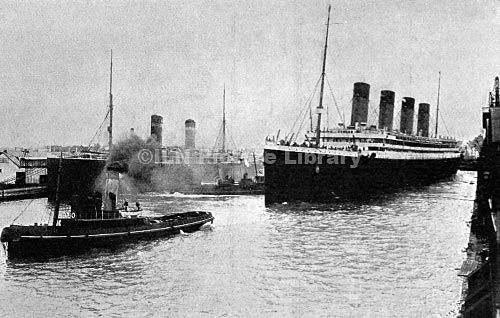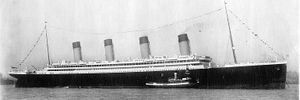 Ships
Ships
» Show All «Prev «1 ... 49 50 51 52 53 54 55 56 57 ... 140» Next» » Slide Show
Olympic
SS Olympic leaving Southampton 1913.
Image Ref: ILN01460

Photograph showing the White Star Liner SS Olympic, leaving Southampton for New York in April 1913. This was her first voyage since safety modifications (larger watertight bulkheads & a double-skinned hull) had been carried out, following the disaster on the Titanic. Olympic was launched by Harland and Wolff, Belfast, in 1910 and at 882 foot long and weighing 45,000 tons, became the largest vessel then afloat. She was operated on the Atlantic service, between Britain and North America, from 1911 to 1914. From 1915 to 1918 Olympic gave service as a troop ship, then returned to work on the Atlantic service. She was retired and scrapped in 1935.
One of the passengers was Harris William Reid from this Family Tree.

OLYMPIC 1910
Built by Harland & Wolff, Belfast for the White Star Line, she was a 45,324 gross ton ship, overall length 883ft x beam 92.5ft, four funnels, two masts, triple screw and a service speed of 21 knots. There was accommodation for 735-1st, 674-2nd and 1,026-3rd class passengers. Her keel was laid on 16/12/1908 and she was launched on 20/10/1910. She commenced her maiden voyage from Southampton to Cherbourg, Queenstown (Cobh) and New York on 14/6/1911. On 20/9/1911 she collided with the British cruiser HMS HAWKE in the Solent, was held to blame for the collision and was repaired at Belfast. She resumed Southampton - Cherbourg - Queenstown - New York voyages on 30/11/1911, but was again taken out of service between 1912-13 for extensive rebuilding after the TITANIC disaster. Rebuilt to 46,359 tons and with a complete inner skin and increased number of lifeboats, she resumed service on 2/4/1913. In October 1914 she made an unsuccessful attempt to tow the battleship HMS AUDACIOUS to port after she had struck a mine, and in September 1915 was taken up as a troop ship. On 12/5/1918 she rammed and sank the German submarine U.103 near Lizard Point and started her first voyage after the Armistice on 8/12/1918 when she left Southampton for Halifax with 5,000 Canadian troops. On 12/2/1919 she started her first Liverpool - Brest - New York voyage and in July 1919 made her last voyage from Halifax to Liverpool as a troop ship. She then sailed to Belfast where she was reconditioned and converted from coal to oil burning. She resumed Southampton - Cherbourg - New York sailings on 25/6/1920 and on 22/3/1924 was in collision with the Furness Line's FORT ST.GEORGE near New York and damaged her stern post. In 1928 her accommodation was altered to 1st, 2nd, tourist and 3rd class and in October 1931 was again altered to carry 618-1st, 447-tourist and 382-3rd class passengers. On 16/5/1934 she rammed and sank the Nantucket lightship in fog, and later the same year came under the ownership of the newly formed Cunard-White Star Line. Her last Southampton - Cherbourg - New York voyage started on 27/3/1935 and she was then laid up at Southampton. Sold in September 1935, she arrived at Jarrow on 13/10/1935 for breaking up, and on 19/9/1937 her hulk was towed to Inverkeithing for final demolition. [North Atlantic Seaway by N.R.P.Bonsor, vol.2,p.765]
Owner: White Star Line, Oceanic Steam Navigation Company.
Port of Registry: Liverpool, England.
Builder: Harland and Wolff, Belfast, Ireland.
Launch Date: 20 October 1910
In Service Date: 14 June 1911
Scrapped: September 1935
Built for White Star Line by Harland and Wolff, the Olympic was the first of a new class of liners designed to challenge the Cunard steamers Lusitania and Mauretania.
In 1907, Joseph Bruce Ismay, of White Star, and William Pirrie, of Harland and Wolff, developed the concept of two large steamers, to be followed by a third to compete with the Cunard speedsters. Recognizing the expense of attempting to compete with the speed of the Cunard vessels, it was decided to build these vessels as the epitome of luxurious accomodation that could transport their passengers in a slightly slower, but much more comfortable manner.
The keel for Olympic was laid at the Queen's Island yard in 1909 and the completed hull launched on 20 October, 1910. The fitting out was completed and the vessel handed over to her owners on 31 March, 1911, the same day her younger sister was launched.
Olympic was involved in a collision with the Royal Navy cruiser HMS Hawke, on 20 September, that necessitated her return to Belfast for repairs. Another mishap, in early 1912, involved the vessel throwing a propellor blade, again necessitating a return to Belfast.
Following the sinking of Titanic, Olympic once again returned to Belfast, this time for an extensive refit, designed to make her impervious to what befell her sister. The refit took six month to complete and she returned to service with a tonnage of 46,359.
During World War I the vessel was requisitioned by the Government and spent the entire war ferrying troops. Two incidents during the war served to tag Olympic as the "Old Reliable." In October of 1914, the battleship HMS Audacious had struck a mine and was sinking. Olympic arrived and attempted, unsuccessfully, to tow the stricken vessel to safety. The other event saw Olympic in the sights of Germany's U-103. Evading a torpedo, Olympic was turned and rammed her attacker, sinking it.
Following the war, Olympic was refitted as an oil burner. During the twenties the vessel continued to be popular. She was used for a short time, in tandem with Majestic, as a quick ferry between New York and Halifax.
Shortly after the merger of Cunard and White Star, Olympic was involved in another collision, this time ramming and sinking the Nantucket Lightship.
Finally, in March 1935, the vessel was laid up in Southampton. In September of that year the vessel was sold to Sir John Jarvis for �100,000. The vessel was taken to Jarrow, where its interiors were removed and auctioned off. The superstructure was then removed from the vessel and the hulk subsequently relocated to Inverkeithing for final demolition.
| Linked to | David John ANDREW |
» Show All «Prev «1 ... 49 50 51 52 53 54 55 56 57 ... 140» Next» » Slide Show
